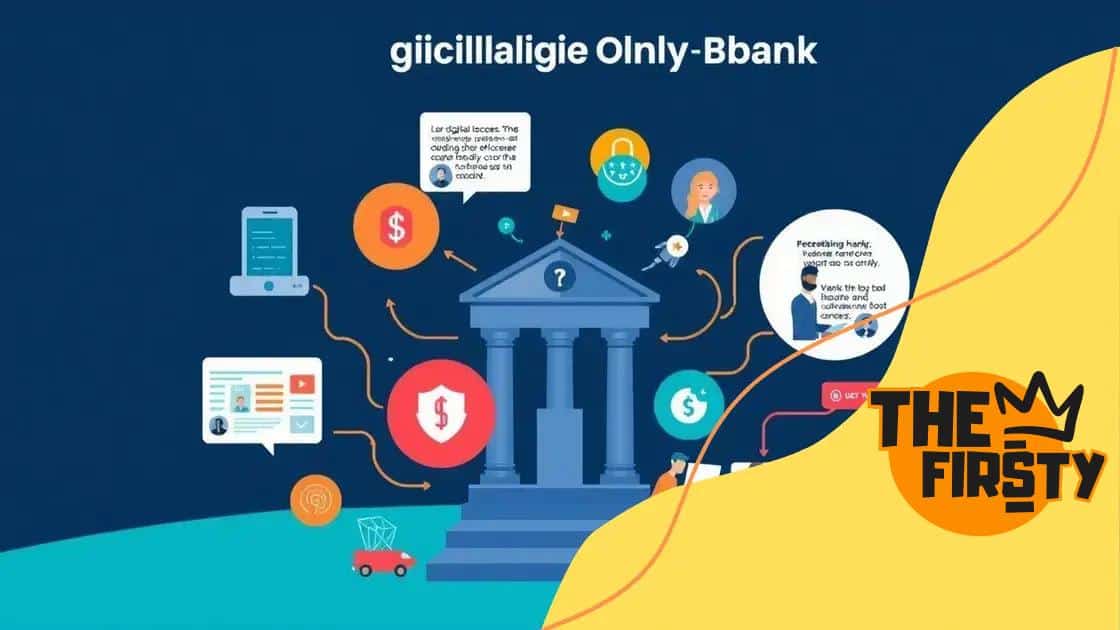The rise of digital-only banks in global financial markets

Anúncios
The rise of digital-only banks in global financial markets enables more accessible, cost-effective banking solutions, leveraging technology to enhance user experience and promote financial inclusion.
The rise of digital-only banks in global financial markets is more than just a trend; it’s a revolution. Have you ever wondered how these banks operate without physical branches and yet attract millions of customers? Let’s dive into this fascinating world.
Anúncios
What are digital-only banks?
Digital-only banks are financial institutions that operate entirely online, without any physical branches. This innovative approach allows them to provide services at lower costs and with greater convenience than traditional banks.
These banks typically offer standard banking services such as checking and savings accounts, loans, and investment options, but everything is done through smartphone apps or websites. This shift to a digitized banking experience is rapidly gaining traction worldwide.
Key Features of Digital-Only Banks
Understanding the main characteristics of digital-only banks is essential to grasp their impact on the financial landscape:
Anúncios
- Lower Fees: Digital-only banks often charge fewer fees compared to brick-and-mortar banks.
- 24/7 Accessibility: Customers can access their accounts anytime, making banking more flexible.
- User-Friendly Interfaces: Most digital banks have simple and intuitive platforms designed for easy navigation.
- Quick Services: Opening an account or getting a loan can often be completed in minutes online.
Furthermore, digital-only banks prioritize customer experience. Many utilize advanced technology and data analytics to tailor services and improve customer support. For instance, customers can instantly chat with customer service representatives or use AI chatbots for quick queries.
This banking model is not without its challenges, though. Issues such as cybersecurity and customer trust remain crucial as these banks grow. Ensuring that personal data is protected while maintaining a seamless user experience is a constant balancing act.
Despite these challenges, the benefits of digital-only banks are attracting many customers. They offer a modern solution for anyone looking for efficient banking services without the hassle of traditional banking processes.
Benefits of using digital-only banks
Digital-only banks offer several advantages that are reshaping the banking experience for consumers. At the forefront is the convenience they provide. With services available 24/7, customers can manage their finances at any time, right from their smartphones or computers.
Cost Savings
One major benefit of using digital-only banks is the potential for lower fees. Traditional banks often come with high maintenance fees and transaction costs. In contrast, digital-only banks frequently have fewer overhead costs, passing those savings on to customers.
- No Monthly Maintenance Fees: Many digital banks do not charge monthly account fees, allowing you to keep more of your money.
- Lower ATM Fees: Some digital-only banks offer fee-free ATM access or reimbursements for out-of-network ATM fees.
- Competitive Interest Rates: Digital banks often provide higher interest rates on savings accounts due to their lower operational costs.
Another benefit is the ease of account management. Opening an account is usually a quick process, often completed entirely online. Customers no longer have to visit a bank branch in person, which saves time and effort. Additionally, the simplicity of the interfaces means that banking is straightforward, even for those who are not tech-savvy.
Enhanced Security
Digital-only banks also emphasize advanced security features to protect customer data. With the rise of cyber threats, many digital banks implement biometric security measures, such as fingerprint or facial recognition, to enhance account protection. They also often use encryption technology to ensure that transactions and sensitive information remain secure.
Furthermore, customer service in digital-only banks has improved significantly. Many offer real-time support through chat functions, enabling customers to get help almost instantly. This accessibility can enhance overall customer satisfaction and loyalty.
The flexibility and functionality of digital-only banks make them an appealing choice for a wide range of consumers. Whether you are a tech-savvy individual or someone looking for straightforward banking solutions, digital-only banks can meet your needs effectively.
Challenges faced by digital-only banks

Digital-only banks face unique challenges in the ever-evolving financial landscape. Despite their many advantages, these banks must navigate several hurdles to establish trust and maintain customer satisfaction.
Cybersecurity Concerns
One of the most significant challenges is cybersecurity. With increased reliance on technology, digital-only banks are prime targets for cybercriminals. Protecting sensitive customer information requires constant vigilance and investment in advanced security systems.
- Data Breaches: Even a single data breach can damage a bank’s reputation and customer trust.
- Fraud Prevention: Digital banks must implement robust fraud detection systems to safeguard accounts.
- Compliance with Regulations: They must adhere to strict regulations surrounding data protection and privacy.
Another challenge these banks encounter is customer trust. Many consumers are still hesitant to fully embrace banking without physical branches. The absence of in-person services can lead to skepticism over the reliability and security of digital-only banks. Building a strong brand and clear communication about security measures is crucial for fostering trust.
Limited Product Offerings
Additionally, digital-only banks may have a more limited range of financial products compared to traditional banks. While they often excel at basic banking services, they might not offer complex investment options or personalized financial advice. This limitation can deter customers seeking comprehensive financial solutions.
Moreover, the competition among digital banks is fierce. As more players enter the market, standing out becomes increasingly difficult. Banks must focus on user experience and innovation to capture and retain customers effectively. This can create pressure to constantly update their technology and services, which may lead to operational challenges.
A final challenge that many digital-only banks face is attracting a diverse customer base. While younger generations often embrace online banking, older customers may prefer traditional banks. Addressing these different needs requires targeted marketing strategies and perhaps even product adaptations.
How digital-only banks are transforming finance
Digital-only banks are transforming finance by changing how people interact with money. These banks have embraced technology to create a seamless banking experience. Their approach is altering the landscape of traditional banking, making it easier and more accessible for everyone.
Revolutionizing Customer Experience
One of the most significant transformations is in customer experience. Digital-only banks focus on user-friendly interfaces that simplify banking tasks. Customers can open accounts, make transfers, and apply for loans within minutes, all from their devices.
- Instant Access: Customers can access their accounts anytime and anywhere.
- Simplified Processes: Many routine banking tasks are streamlined to reduce hassle.
- Personalized Services: Banks use data to tailor services to individual needs.
Moreover, digital-only banks are pioneering innovative financial products, often geared towards younger consumers and those seeking flexibility. For instance, many offer savings accounts with higher interest rates or budgeting tools that help track spending effectively.
Promoting Financial Inclusion
Digital-only banks also play a vital role in promoting financial inclusion. They reach underserved populations who might not have easy access to traditional banks. By providing basic banking services online, these institutions help bridge the gap for those who lack local banking options.
Furthermore, these banks use technology to lower costs, enabling them to offer lower fees and better rates compared to traditional banks. This financial accessibility allows more individuals to participate in the financial system, which can lead to improved economic stability.
Security is another critical aspect of the transformation. Digital banks invest heavily in cybersecurity measures to protect their customers. By implementing advanced technologies, they aim to ensure safe transactions and secure data storage. This focus on security helps build trust with users, further propelling the shift to digital banking.
Overall, the rise of digital-only banks is significantly reshaping the financial landscape, emphasizing convenience, inclusion, and security. As they continue to evolve, these banks are likely to drive even more changes in how individuals manage their finances, setting new standards in the industry.
The future of digital-only banks in global finance
The future of digital-only banks in global finance is shaping up to be both exciting and transformational. As technology continues to evolve, these banks are well-positioned to lead innovations in the financial sector.
Adoption of Advanced Technologies
One significant change we can expect is the increased use of advanced technologies. Digital-only banks are likely to adopt artificial intelligence and machine learning to enhance their services. These technologies can provide personalized banking experiences, allowing customers to receive tailored financial advice based on their spending habits.
- Smart Savings Tools: Advanced algorithms can help customers save money by analyzing their transactions.
- Automated Customer Service: AI chatbots can provide quick and efficient assistance.
- Fraud Detection: Machine learning can help identify suspicious activities before they become significant issues.
The expansion of financial services will also play a crucial role in the future of digital-only banks. Many are already exploring partnerships with fintech companies to offer a broader range of products, such as investment services and insurance. By diversifying their offerings, these banks can better meet customer needs and stay competitive.
Regulatory Developments
As digital banking grows, regulatory frameworks will need to adapt. Governments and financial authorities will likely implement new regulations to ensure consumer protection without stifling innovation. Striking the right balance between regulation and flexibility will be essential for the continued growth of digital-only banks.
Another important aspect is sustainability. The future will likely see digital-only banks focusing on eco-friendly financial products, reflecting growing consumer demand for environmentally responsible practices. This could include green investment options and promoting sustainable spending habits among customers.
In addition, as more people around the world adopt digital banking, financial inclusion will become a priority. Digital-only banks can reach underserved populations in remote areas, offering them access to banking services that were previously unavailable.
Overall, the landscape of global finance will be significantly transformed by the ongoing evolution of digital-only banks. By embracing technology, expanding services, adapting to regulations, and focusing on inclusivity and sustainability, these banks are set to redefine how we think about banking.
Conclusão:
Bancos digitais estão mudando a maneira como pensamos sobre bancos. Eles oferecem conveniência, taxas mais baixas e serviços inovadores que atendem às necessidades modernas. Ao abraçar a tecnologia, esses bancos podem proporcionar experiências personalizadas e promover a inclusão financeira. À medida que evoluem, continuarão a moldar o futuro das finanças, tornando o banco mais acessível e eficiente para todos.
FAQ – Frequently Asked Questions about Digital-Only Banks
What are digital-only banks?
Digital-only banks are financial institutions that operate exclusively online, offering services without physical branch locations.
What benefits do digital-only banks provide?
They offer lower fees, 24/7 access, and user-friendly interfaces, making banking more convenient and cost-effective.
How secure are digital-only banks?
Digital-only banks invest heavily in cybersecurity measures to protect customer data, such as encryption and biometric authentication.
Will digital-only banks continue to grow in the future?
Yes, as technology advances and customer preferences shift, digital-only banks are expected to expand, offering more innovative services and promoting financial inclusion.





